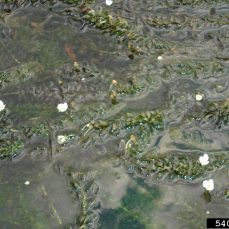
Photo credit: Barry Rice, sarracenia.com, Bugwood.org

Management Category
Squamish
Whistler
Pemberton
Vectors of Spread
Synonyms
Brazillian waterweed, Leafy elodea
ID Characteristics
General: Brazilian elodea is a freshwater aquatic perennial plant.
Flowers: Small with three white petals that are found above the water.
Stem: Are delicate and break easily. Stems can grow form 10 – 90 cm until they reach the surface of the water.
Leaves: Are bright green, lance-shaped and minutely serrated. Leaves are 1 – 3 cm long and arranged in whorls of 3 – 6 along the stem.
Fruit: When pollinated, Brazilian elodea produces 7 – 8 mm long oval berries with membranous and transparent skin.
Roots: Are filament-like and found at the base of plants or on some plant nodes.
Similar Species
Native

Rob Routledge, Sault College, Bugwood.org
Canada waterweed (Elodea canadensis) has 3 smooth leaves in a whorl; each leaf is 1.5 cm long (smaller than Brazilian elodea leaves).
Invasive

Cleveland Metroparks, Bugwood.org
Hydrilla (Hydrilla verticillata) has prickly hairs on the underside of its leaves, and the leaves form in a whorl of 3 – 8.
Habitat and Origin
Brazilian elodea is originally from South America, and was introduced to North America through the aquarium trade as an oxygenator and decorative plant for aquariums.
It is found in freshwater lakes, rivers or other shallow and still/slow-moving water. It thrives in water temperatures of 15 – 17°C and tolerates shade.
How it Spreads
Brazilian elodea reproduces primarily vegetatively from stem fragments. It has nodes along the stem that can produce new buds, roots and branches. The plant is dioecious (with male and female plants) and can be pollinated by insects. However, only male plants have been found in North America thus far, so sexual reproduction is not believed to be possible for Brazilian elodea in Canada.
The plant is imported and sold in aquarium shops and maybe improperly disposed of into water bodies. Brazilian elodea can travel short distances with water currents; the plant parts can also attach to boats and be transported long distances.
Impacts
Ecological:
- Forms dense mats that restrict water movement, affecting water quality and crowding out native plants.
- Alters hydrology and can change and deplete oxygen levels at night, which can kill fish.
- Blocks watercourses which can impact fish migration.
Economic:
- Dense infestations can affect recreation activities such as fishing, swimming or boating.
- Disrupts hydroelectric operations.
Prevent the Spread
Brazilian elodea is NOT currently found in the Sea to Sky Corridor, so the best approach to controlling its spread is by PREVENTION.
This is a high-priority invasive species for the Province of BC, and it is included in the Early Detection and Rapid Response (EDRR) program.
If you see Brazilian elodea, please report it.
B.C. Distribution
Brazilian Elodea Factsheet
Having trouble viewing the factsheet? Don’t worry, all the information is included on this page. You can also contact us with any questions.









